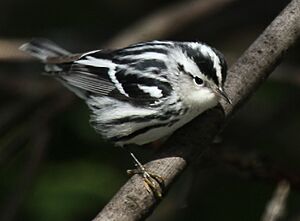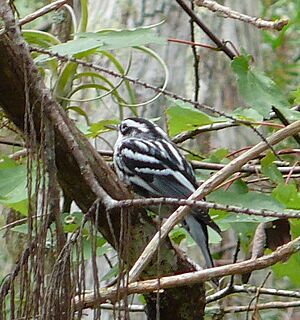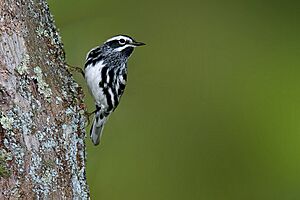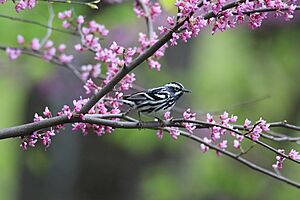Black-and-white warbler facts for kids
Quick facts for kids Black-and-white warbler |
|
|---|---|
 |
|
| Conservation status | |
| Scientific classification | |
| Genus: |
Mniotilta
|
| Species: |
varia
|
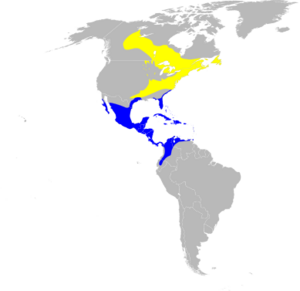 |
|
| Range of M. varia Breeding range Wintering range | |
| Synonyms | |
|
Motacilla varia Linnaeus, 1766 |
|
The black-and-white warbler (Mniotilta varia) is a small, striped bird found in North and South America. It's easy to spot because of its unique black and white feathers! This bird is the only one of its kind in the Mniotilta group. These warblers spend their summers in northern and eastern North America. When winter comes, they fly south to places like Florida, Central America, and the West Indies, even as far as Peru. Sometimes, they are even seen in western Europe, but that's very rare!
Contents
What Does a Black-and-white Warbler Look Like?
Black-and-white warblers are small birds, usually about 11 cm (4.3 in) to 13 cm (5.1 in) long. They weigh about 8 g (0.28 oz) to 15 g (0.53 oz) grams, which is about as much as a few paper clips! Their wings can spread out to about 18 to 22 cm.
As their name suggests, these warblers are mostly black and white. Both male and female birds have black and white stripes on their heads, with a white stripe above their eyes. Their bellies are white with black streaks. Their wings are black with two white stripes, and their tails are black. Their backs are also streaked with black and white.
Male warblers that are ready to breed have a black and white striped throat and black cheeks. Females have gray cheeks and a white or cream-colored throat. Young males look a lot like adult females. Young females look like adult females but have fewer streaks. Baby warblers are quite spotty.
This bird is sometimes called a "flying humbug" because of its bold black and white stripes!
Where Do Black-and-white Warblers Live?
The black-and-white warbler is a migratory bird. This means it travels long distances between its summer homes and its winter homes.
Favorite Places to Live
These warblers can live in many different types of places. In the summer, where they raise their young, they prefer mature forests. But they can also be found in younger forests or forests that are regrowing. They especially like forests with deciduous trees (trees that lose their leaves) and mixed forests. Sometimes, they even live in swampy forests.
When they are migrating (traveling), they prefer forests, especially areas near rivers or streams. In their winter homes, they can live in many places, from mangrove swamps to wet, dry, or cloud forests. They also like coffee farms that grow coffee under shady trees, and even gardens!
Male warblers protect their own areas, both in their summer and winter homes.
Where They Are Found
Black-and-white warblers breed in northern and eastern North America. Their summer range stretches from the Northwest Territories in Canada all the way down to North Carolina and Texas in the United States.
For winter, they fly south to Florida, Central America, the West Indies, and northern South America, reaching as far as Peru. The total area where these birds live is huge, about 11,500,000 square kilometers!
Sometimes, these birds get lost during migration and end up in unusual places like Iceland, Ireland, the Faeroes, and the UK.
How Black-and-white Warblers Behave
What Do They Sound Like?
The black-and-white warbler has a high-pitched song. It sounds like a repeating wee-see sound, often repeated at least six times in a row. They also have a short chip call and a soft seet-seet call that they sometimes make while flying. Their song can also sound like see wee-see wee-see wee-see wee-see wee-see or weesa weesa weetee weetee weetee weet weet weet.
What Do They Eat?
These birds love to eat insects and spiders. Unlike many other warblers, they search for food in a special way. They move up and down tree trunks and along branches, much like a nuthatch bird does. They use their short legs and a long back toe to help them grip the bark.
They look for insects and other small creatures under the bark. Their diet includes caterpillars, beetles, ants, and spiders. When they are migrating or raising their young, caterpillars are a very important part of their diet. Sometimes, during migration, they join groups of other birds to find food together.
How Do They Reproduce?
Black-and-white warblers are among the first warblers to return to their breeding grounds in the spring. In warmer southern areas, they might start breeding in mid-April. Male warblers sing and chase away other males to protect their territory. When a female enters a male's territory, he will try to attract her to breed.
Their nests are shaped like a cup and are usually built on the ground. They often place their nests among tree roots, against a tree trunk, or in cracks in tree stumps. They prefer damp areas for nesting. The female builds most of the nest using grass, bark, and dry leaves. She lines it with soft materials like moss and hair.
The female lays 4 to 5 eggs. The eggs are light brown with darker brown speckles. The female sits on the eggs to keep them warm for 10 to 12 days. She does this all by herself, though the male might bring her food.
Both parents help feed the baby birds once they hatch. The young birds leave the nest after 8 to 12 days. They stay near the nest while they practice flying. The parents stay close by to watch over them.
These warblers usually have one group of babies each year. Sometimes, another bird called the brown-headed cowbird tries to lay its eggs in the black-and-white warbler's nest, hoping the warbler will raise its young.
Conservation Status
The black-and-white warbler is classified as "Least Concern" by the IUCN. This is because they have a very large range and a big population. However, their numbers are slowly decreasing.
The biggest reasons for this decline are habitat loss and changes to their homes, especially when forests get broken up into smaller pieces. If their habitats continue to disappear, their population might keep shrinking. In the 1970s, some chemicals used to kill pests also caused their numbers to drop.
Images for kids



